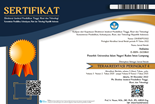Quarter Life Crisis in College Students: How Do Religiosity and Self-Efficacy Affect?
Abstract
This study aims to analyzw the influence of religiosity and self-efficacy on the quarter-life crisis in final-year college students. The respondents in this study were final-year students of UIN Sayyid Ali Rahmatullah Tulungagung. The study had 323 respondents aged around 20-24 years. The research sample was taken using a non-probability sampling technique, with the respondent criteria being final-year students of the 2019 batch of UIN Sayyid Ali Rahmatullah Tulungagung. We used three instruments: the religiosity scale, self-efficacy scale, and quarter-life crisis scale, that had been declared valid and reliable. The data were tested and analyzed using the classical assumption test and multiple linear regression analysis with partial t-test hypothesis testing and simultaneous F-test. The results of the study showed that religiosity and self-efficacy simultaneously had a significant effect on quarter-life crisis and a negative impact on it, meaning that if there were an increase in religiosity and self-efficacy, the level of quarter-life crisis would decrease. The results of the analysis of the percentage of influence of each variable obtained a percentage value of negative impact on quarter-life crisis of 6.9% on the religiosity variable and 19.6% on the self-efficacy variable. This finding implies that increasing the religiosity and self-efficacy of students can be an effective strategy to reduce psychological stress related to quarter-life crises and can be used as a basis for developing prevention and intervention programs in higher education environments
Keywords: religiosity, self-efficacy, quarter life crisis
Full Text:
PDFReferences
Afnan, A., Fauzia, R., & Tanau, M. U. (2020). Hubungan Efikasi Diri dengan Stress pada Mahasiswa yang Berada Dalam Fase Quarter Life Crisis. Jurnal Kognisia: Jurnal Mahasiswa Psikologi Online, 3(1), 23–2. https://ppjp.ulm.ac.id/journals/index.php/kog/article/view/1569
Afrilia, D. D. (2022). Hubungan antara Religiusitas dengan Quarter Life Crisis pada Mahasiswa Tingkat Akhir UIN Walisongo Semarang. Universitas Islam Negeri Walisongo. https://eprints.walisongo.ac.id/id/eprint/17569/1/Skripsi_1804046100_Devika_Dian_Afrilia.pdf
Arnett, J. J. (2004). Emerging Adulthood: The Winding Road from the Late Teens through the. Twenties. Oxford University Press.
Badriyah, S. A. (2022). Hubungan Antara Self-Efficacy dengan Quarter Life Crisis pada Dewasa Awal. Universitas Muhammadiyah Malang. https://eprints.umm.ac.id/91742/
Bandura, A. (1997). Social Foundation of Thought and Action. Prentice Hall.
Bandura, A., & Wessels, S. (1994). Self-Efficacy.
Fauzi, M. (2009). Metode Penelitian Kuantitatif Sebuah Pengantar. Cetakan Pertama. Walisongo Press.
Fischer, K. (2008). Ramen Noodles, Rent and Resumes: An After-College Guide to. Life. SuperCollege LLC.
Ghozali, I. (2011). Aplikasi Analisis Multivariat dengan Program IBM SPSS 19. Badan Penerbit Universitas Diponegoro.
Glock, C. Y., & Stark, R. (1988). Dimensi-dimensi Keberagamaan. Dalam Robertson, Roland (ed.), Agama: Dalam Analisa dan Interpretasi Soiologi. CV Rajawali.
Grehenson, G. (2022). Tim Mahasiswa UGM Teliti Fenomena Quarter Life Crisis yang Melanda Anak Muda. https://ugm.ac.id/id/berita/23161-tim-mahasiswa-ugm-teliti-fenomena-quarter-life-crisis-yang-melanda-anak-muda/
Haase, C. M., Heckhausen, J., & Silbereisen, R. K. (2012). The Interplay of Occupational Motivation and Well Being During the Transition from University to Work. Developmental Psychology, 48(6), 173. 48(6). https://doi.org/10.1037/a0026641
Habibie, A., Syakarofath, N. A., & Anwar, Z. (2019). Peran Religiusitas Terhadap Quarter-Life Crisis (QLC) Pada Mahasiswa. Gadjah Mada Journal Of Psychology (Gamajop). https://doi.org/10.22146/gamajop.48948
Ilmiah, A. F. (2022). Pengaruh Efikasi Diri dan Dukungan Sosial terhadap Quarter Life Crisis Mahasiswa Tingkat Akhir Universitas Islam Negeri Maulana Malik Ibrahim Malang. Universitas Islam Negeri Maulana Malik Ibrahim Malang. http://etheses.uin-malang.ac.id/45039/
Isaac, S., & Michael, W. B. (1981). Hand Book in Research and. Evaluation, 2nd Edition. Edit Publishers.
Jalaluddin. (2007). Kesehatan Mental. UIN SUKA.
Karim, D. F. (2022). Peran Religiositas terhadap Quarter Life Crisis pada Fresh Graduate di Masa Pandemi Covid-19. Universitas Muhammadiyah Malang. https://etd.umm.ac.id/id/eprint/511/
Khoironi, & Huwaina, M. (2021). Peningkatan Kelentingan Nilai-Nilai Shalat. Pada Anak Usia Dini. Cipta Media Nusantara.
King, L. A. (2014). Psikologi Umum: Sebuah Pandangan Apresiatif. Salemba Humanika.
Larasati, D. (2021). Peran Religiusitas Dalam Menghadapi Quarter Life Crisis. Universitas Muhammadiyah Malang. https://eprints.umm.ac.id/78834/
Murphy, M. (2011). Emerging Adulthood in Ireland: Is the Quarter-Life Crisis a Common Experience? Dublin Institute of Technology.
Nash, R. J., & Murray, M. C. (2010). Helping Collenge Students Find Purpose: The Campus Guide to Meaning-Making. Jossey Bass.
Nurdhifa, A. R. (2020). Hal Paling Dicemaskan saat Quarter Life. Crisis. GENSINDO. https://gensindo.sindonews.com/
Robbins, A., & Wilner, A. (2001). Quarterlife Crisis: The Unique Challenges of Life in Your Twenties. Penguin Putnam Inc.
Somadikarta, S. (1996). Buku informasi Universitas Indonesia. UI Press.
Sujarweni, W. (2015). SPSS Untuk Penelitian. Pustaka Baru.
Suroso, A. R., & Pratitis, N. T. (2021). Psychological Well Being, Self Efficacy Dan Quarter Life Crisis Pada Dewasa Awal. Universitas 17 Agustus Surabaya. http://repository.untag-sby.ac.id/8006/9/Jurnal.pdf
Taylor, S. E., Peplau, L. A., & Sears, D. O. (2009). Psikologi. Sosial Edisi Kedua Belas. Kencana Prenada Media Group.
Yusuf. (2012). Psikologi Perkembangan Anak dan Remaja. Remaja Rosdakarya.
DOI: http://dx.doi.org/10.24042/ajp.v8i1.18337
Refbacks
- There are currently no refbacks.
Copyright (c) 2025 Thoirotul Mar'atus Sholikhah, Ahmad Fauzan













